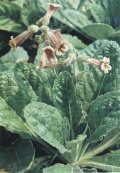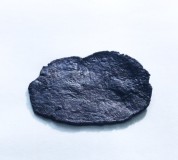Prepared Rehmannia Root
http://www.100md.com
《e Natural Health Center》
 |
 |
 |
Blood Tonics
Prepared Rehmannia Root
Latin:
Radix Rehmanniae Praeparata
Origin:
The prepared root of Rehmannia glutinosa Libosch., Rehmannia glutinosa (Gaertn.) Steud., Rehmannia chinensis (.), or Huaiqing R. glutinosa Libosh. f. hueichingensis (Chao et Schih) Hsiao., a perennial plant, of the family Scrophulariaceae. Native to Northern China, the plant is also grown on well-drained stony ground along roadsides and in woods in Korea and Japan.
, http://www.100md.com
Rehmannia is a beautiful genus of plants which has been extensively used and cultivated in China for over 2000 years. This particular species grows to about 0.3 m by 0.25 m. It is in flower from April to June. The flowers are hermaphrodite (have both male and female organs). The plant can grow in semi-shade (light woodland) or no shade. It requires moist soil.
Glutinosa means "very sticky," which refers to the condition of the form, particularly of the prepared rehmannia root.
, 百拇医药
In China, rehmannia glutinosa is produced mainly in Inner Mongolia, Henan, Zhejiang, Hebei, and Liaoning provinces. The root is dug in October and September, dried by fire and steamed with yellow rice wine or charcoaled for use.
Also called Prepared Chinese Foxglove Root.
See also Herbs, Heat Clearing Herbs to Clear Heat and Cool the Blood, Rehmannia Root.
Properties:
, 百拇医药
Sweet in flavor, slightly warm in nature, it is related to the heart, liver and kidney channels.
Functions:
Replenishes blood and tonifys yin.
Prepared rehmannia root is one of the most popular tonic herbs and is one of 50 fundamental herbs used in traditional Chinese medicine. Being sweet in flavor, warm, moist and greasy in nature, it can replenish heart- and liver-blood and also can nourish both liver- and kidney-yin, serving as a main herb for warming and enriching essence and blood.
, 百拇医药
It is often used to treat syndromes of blood-deficiency, deficiency of both liver-yin and kidney-yin as well as severe insufficiency of kidney essence. But due to its greasy property which is easy to hinder the digestive function of stomach, it is usually used with herbs for resolving dampness and appetising, such as fructus Amonmi, etc.
Applications:
1. For blood deficiency syndrome manifested as pale, dizziness, tinitus, palpitation, insomnia, irregular menstruation, it is often used together with Radix Angelicae Sinensis, Rhizome Ligustici Chuanxiong and Radix Paeoniae Alba to enrich blood and regulate menstruation, as in Decoction of Four Ingredients (Siwu Tang).
, 百拇医药
2. For yin-deficiency of both the liver and kidney marked by lassitude of the loins and legs, dizziness, tinitus, night sweat, spermatorrhea, fever due to yin-deficiency, it is often used with Rhizoma Dioscorear, Fructus Corni, Cortex Moutan Radicis, Rhizoma Anemarrhenae to nourish yin, replenish kidney, clear away heat and reduce ministerial fire, as in Bolus of Six Herbs Including Rehmannia (Liuwei Dihuang Wan).
Besides, it can also be used to treat diabetes with internal heat.
, 百拇医药
Dosage and Administration:
1O-15 g.
30 g. at large dose.
This herb is sticky and greasy in property and can hinder digestion, so it is usually used with appetising herbs such as Fructus Amomi, Pericarpium Citri Reticulatae, etc.
Cautions on Use:
Overuse can lead to abdominal distension and loose stools. Therefore, avoid excessive use if one suffers from loose stools or a very coated tongue.
, http://www.100md.com
Other side effects that have been observed with prepared rehmannia root are mild and include diarrhea, abdominal pain, dizziness, lack of energy, and palpitations. These symptoms usually disappear on continued administration of the herb.
Because prepared rehmannia root contains cardio-active glycosides, the herb should not be taken concurrently with pharmaceutical heart medications.
Reference Materials:
, http://www.100md.com
'Shen Nong's Herbal Classic' :
"Treats fracture, traumatic injuries, rupture of the muscles and tendons and impairment of the spleen and stomach by relieving blood-arthralgia, replenishing marrow and promoting tissue regeneration."
'Other Medical Records of Famous Physicians' :
"A man's five kinds of consumptive diseases and seven kinds of impairment as well as a woman's impairment of the spleen and stomach, vaginal bleeding during pregnancy and metrorrhagia and metrostaxis."
, 百拇医药
'Powerful and Unusual Herbs from the Amazon and China,' (The World Preservation Society, Inc., 1993,1995) :
"Rehmannia is commonly used in clinics in the orient and is called di-huang, or 'yellow earth.' It is used to replenish vital force and helps with diabetes, constipation, urinary tract problems, anemia, dizziness, and regulating menstrual flow. It is protective to the liver and helps prevent the depletion of stored glycogen (a white amorphous tasteless polysaccharide (C6H10O5)x that is the principal form in which carbohydrate is stored in animal tissues and especially muscle and liver tissue), which can make it beneficial for hypoglycemia (abnormal decrease of sugar in the blood). Di huang has an antifungal effect and has been used for candida (a genus of fungus). It can lower glucose levels and helps to reduce blood pressure while increasing circulation to the brain. It is a blood tonic and diuretic. It helps strengthen the bones and tissue and can enhance fertility. Chinese doctors have used it with licorice for the treatment of hepatitis. Rehmannia helps disperse heat from the body and alleviates night sweats and fevers."
, 百拇医药
Toxic or Side Effects:
Modern Researches:
Rehmanniae contains phytosterols (B-sitosterol, stigmasterol), glycosides, saponins, sugars (mannitol), rehmannin, tannin, etc.
This herb has cardio tonic, diuretic, hypotensive and anti-diabetic effects.
The charcoaled root is used to stop bleeding and tonify the spleen and stomach.
, http://www.100md.com
The dried root is used to treat bleeding due to blood deficiency and to nourish the vital essence.
The prepared root is used to treat dizziness and palpitations due to anaemia or blood deficiency, chronic tidal fever, night sweats, dry mouth, lumbago and nocturnal emissions.
The leaves are bruised and used in the treatment of scaly eczema or psoriasis.
It is reported in 'Eating Your Way to Health' that in one clinical series for the treatment of hypertension, 62 patients with hypertension took Rehmannia for two weeks. The mean blood pressures and serum cholesterol levels decreased, and there was improvement in cerebral blood flow and the ECG., 百拇医药